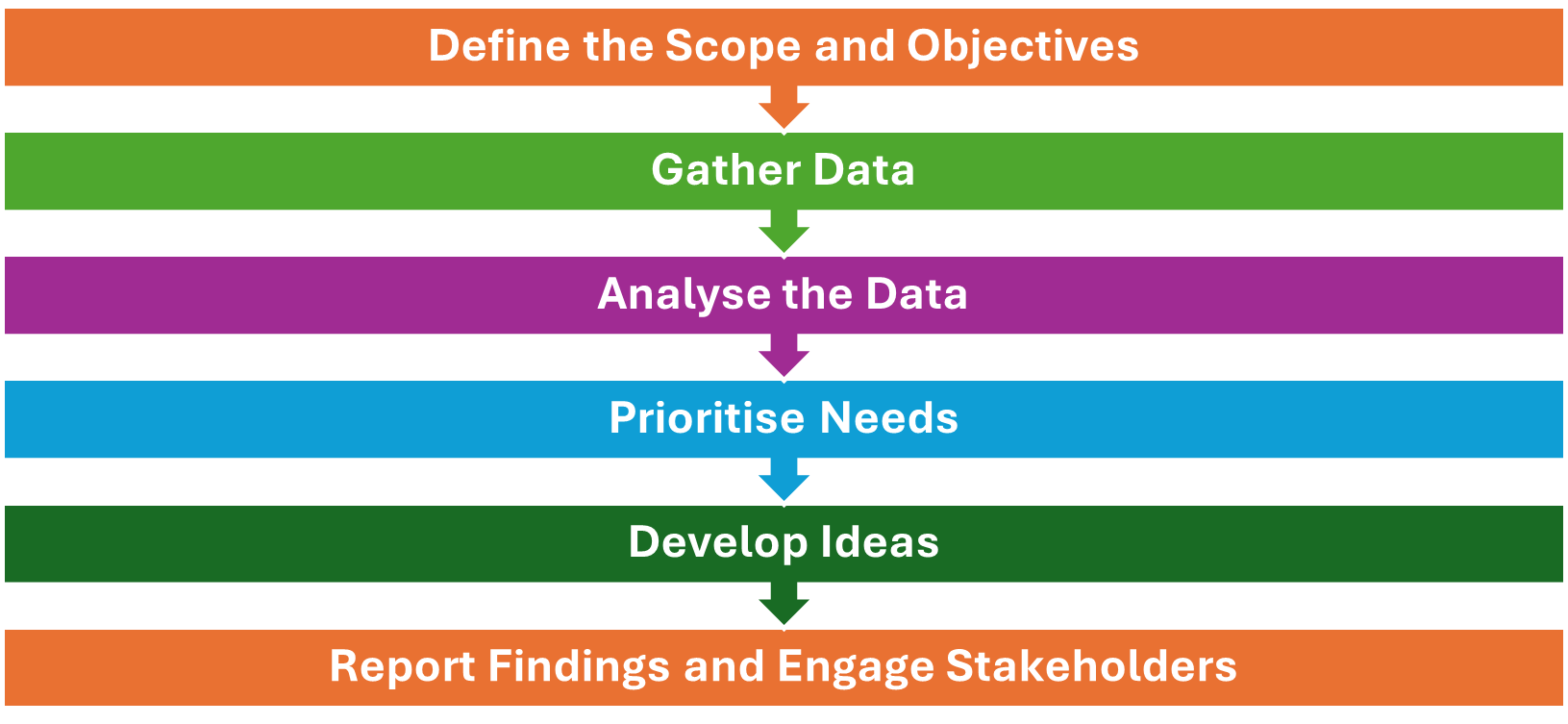Chapter 3: Assessing the Current Landscape

Before embarking on the journey of implementing a digital strategy in schools, it is essential to understand the existing landscape of technology, resources, and educational practices. Conducting a thorough needs assessment will provide insights into the strengths and weaknesses of the current setup, help identify areas for improvement and ensure that the digital strategy aligns with the school’s goals. This chapter will guide you through the process of assessing your school's current technological environment, engaging stakeholders, and setting clear objectives for your digital strategy.
Needs Assessment
A needs assessment is a systematic process used to identify and understand the gap between the current conditions and the desired goals of an organisation. In the context of developing a digital strategy for a school, this process helps to ensure that the technology plan is tailored to meet the specific needs of the school community, including students, staff, operational staff and parents. A thorough needs assessment helps schools make informed decisions about resource allocation, infrastructure investments, and professional development. It sets the stage for a digital strategy that enhances teaching, learning, and operational efficiency.
Why Conduct a Needs Assessment?
Conducting a needs assessment is a critical first step in developing a school's digital strategy for several reasons. First, it ensures that digital tools and technologies are aligned with the school’s educational goals, such as improving learning outcomes, personalising instruction, and preparing students for their digital future. It also helps allocate resources by allowing schools to rank spending on tools, systems, and training that will have the greatest impact, especially within limited budgets.
Involving students, staff, operational personnel, and parents in the process of developing and implementing a digital strategy is crucial for fostering stakeholder buy-in. By engaging members from each element of the entire school community in meaningful ways, schools can ensure that the digital strategy is not only accepted but also actively supported by all involved. When students feel that their needs and learning preferences are considered, teachers have input into the tools and methods they will use in the classroom, and parents understand how digital transformation will benefit their children, a collective sense of ownership emerges. This involvement leads to greater enthusiasm, cooperation, and commitment to the success of the digital strategy. Stakeholder buy-in creates a shared sense of responsibility, encouraging all members of the school community to play their part in making the strategy work.
The assessment helps to identify gaps in the school's current digital capabilities. Schools may discover that they are working with outdated hardware, unreliable internet infrastructure, or that their teaching staff lacks sufficient training to fully utilise digital tools. These deficits can greatly hinder the effectiveness of any digital strategy, but by identifying them early, schools are able to prioritise and address these challenges head-on. This step is vital for making targeted improvements that ensure the technology is accessible, functional, and capable of enhancing the learning experience for all students.
Finally, the assessment also helps schools address critical compliance and safety concerns, which are increasingly important in today’s digital landscape. With technology playing a greater role in education, schools must be vigilant about protecting students' personal information and maintaining secure online environments. By uncovering potential vulnerabilities related to digital security, privacy, and data management, schools can take proactive steps to mitigate risks. This includes ensuring compliance with GDPR and establishing protocols to safeguard students' information. Addressing these concerns not only builds trust among parents and staff but also makes the digital strategy more robust and sustainable in the long run.
Steps in Conducting a Needs Assessment

Define the Scope and Objectives
Begin by outlining the goals of the digital strategy and how the needs assessment will support these objectives. Consider key questions such as “what are the school’s educational goals for integrating technology?” and “what specific learning outcomes does the school aim to achieve through digital tools?”. Reflect on how technology could improve administrative processes, streamlining tasks to enhance overall efficiency. By addressing these questions, the digital strategy will align with the school’s vision while targeting both instructional and operational improvements.
Gather Data
Collect qualitative and quantitative data from a variety of sources to understand the current state of digital integration at the school. This can include distributing surveys to teachers, students, and parents to collect feedback on the current use of technology in teaching, learning, and operational efficiency. Conducting interviews or focus groups with key stakeholders such as administrators, IT staff, operational staff, and department heads can provide deeper insights into the school's specific digital needs.
Classroom observations are also valuable for understanding how technology is currently being used and identifying any limitations in existing tools or teaching methods. Finally, conducting an audit of the school's existing technology infrastructure (covering hardware like computers and tablets, software, internet bandwidth, security protocols, and IT support systems) will offer a comprehensive view of the school's digital readiness.
Analyse the Data
Once the data is collected, it must be carefully analysed to identify the strengths, weaknesses, opportunities, and threats (SWOT) related to the school’s digital situation.
Key considerations during this analysis how current technology is being used; are the available tools are being used to their full potential and if there are areas where technology could be introduced to improve educational and operational outcomes. It’s also important to assess the digital literacy and proficiency levels of teachers, students, and operational staff to determine if additional training or professional development is required. Infrastructure gaps, such as inadequate hardware, slow internet connections, or a lack of IT support, should be identified to address technical shortcomings. A requirement at this stage is to consider the diverse learning needs of students, ensuring that the school’s technology is accessible to all, including those with special educational needs, to provide an inclusive learning environment for every student.
Prioritise Needs
Once the gaps have been identified, prioritise them based on their impact on the school’s overall educational goals and their feasibility within the school’s budget and resources. For example, upgrading the internet infrastructure might take precedence over purchasing new software if the current bandwidth is not sufficient to support existing tools. If teachers lack confidence in using technology, investing in professional development could be prioritised over acquiring new hardware.
Develop Ideas
Based on the findings, develop recommendations that address the identified needs and are actionable. Recommendations should be clear, achievable, and aligned with the school's broader goals: “Invest in 1:1 devices for students to improve personalised learning”, “Provide professional development sessions on using digital tools to differentiate instruction” or “Upgrade internet bandwidth to accommodate increased demand from online learning platforms.”
Report Findings and Engage Stakeholders
Present the results of the needs assessment to key decision-makers and stakeholders, including the school leadership team, teachers, students, and parents. It’s important to communicate the rationale behind the recommended actions and how they will contribute to achieving the school’s goals.
A well-conducted needs assessment is the foundation of a successful digital strategy in schools. It ensures that the chosen digital solutions are relevant, sustainable, and aligned with the school’s educational vision. By engaging stakeholders, gathering comprehensive data, and identifying key priorities, schools can create a digital environment that supports effective teaching and learning while optimising resources. Ultimately, a digital strategy grounded in a needs assessment is more likely to drive positive change, enhance student outcomes, and ensure that the school is equipped to navigate the demands of a digital future.
Stakeholder Engagement
Engaging stakeholders is essential to ensure that the digital strategy aligns with the needs and priorities of the entire school community. Begin by identifying key stakeholders, such as teachers, staff, operational staff, students, parents, administrators, and community members. Facilitate their participation through surveys, interviews, focus groups, and workshops to gather feedback and insights. Encourage open dialogue by fostering an environment where stakeholders feel comfortable sharing their opinions and providing honest feedback. Communicate the findings of the needs assessment transparently, demonstrating that their input has been valued and considered in shaping the strategy.
Setting Clear Goals
Once the needs assessment is complete and stakeholders have been engaged, it is essential to set clear, measurable goals for your digital strategy. Well-defined goals provide direction and focus, making it easier to track progress and success.
Align with the School’s Mission and Vision
Ensure that your digital strategy goals are aligned with the overall mission and vision of the school. This alignment helps create a cohesive approach to education
Use the SMART Framework
Specific: Clearly define what you want to achieve. Measurable: Establish criteria for measuring progress and success. Achievable: Set realistic goals that can be accomplished within a defined timeframe. Relevant: Ensure that goals are meaningful and aligned with the needs of the school community. Time-bound: Set deadlines for achieving each goal.
Involve Stakeholders
Include input from stakeholders when setting goals. This collaborative approach fosters buy-in and ensures that the goals reflect the needs of the entire school community.
Document and Share Goals
Write down the goals and share them with all stakeholders. This documentation serves as a reference point for tracking progress and holding individuals accountable.
Assessing the current landscape is a crucial step in implementing a successful digital strategy. By conducting a thorough needs assessment, engaging stakeholders, and setting clear, measurable goals, schools can lay the groundwork for a digital transformation that meets the needs of students, teachers, and the broader community.
Book
Buy the Empowering
Education Digital Strategy
Book
In Empowering Education: A Comprehensive Guide to Implementing Digital Strategies in Schools, discover how to navigate the ever-evolving world of technology to enhance learning, streamline operations, and prepare students for the future. This book provides step-by-step guidance for creating a tailored digital strategy, from assessing your school's needs and building a collaborative vision, to rolling out initiatives and ensuring ongoing success. With practical insights, case studies, and expert advice, this guide equips educators, administrators, and IT leaders to lead their schools into a digitally empowered future. Perfect for those ready to make a lasting impact through innovative technology integration.


